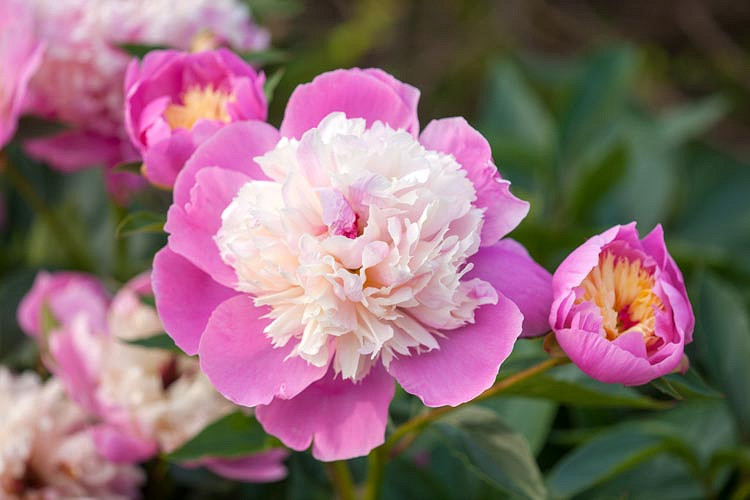Peonies are among the most stunning and well-known flowers that are grown in gardens all over the globe. Because of their big, vivid blossoms and fragrant scents, they can bring class and elegance to any landscaping. In this post, we’ll explore the intriguing history of peony flowers and provide an extensive guide for caring for and growing this beautiful flower.
A Brief History of Peony Flowers
Peonies aren’t just beautiful blooms with a long history and significant cultural meaning. Let’s explore the intriguing nature of the peonies.
Origin and Cultural Significance
Peonies originate from Asia, Europe, and North America and have been cultivated for over 2000 years. They are prized by Chinese tradition and often called “the king of flowers.” In early China, they were believed to possess magical properties and were used for medicinal purposes to treat various ailments. The peony’s roots, seeds, and flowers from the peony plant were utilized to treat multiple conditions, from asthma and headaches to seizures and pain during childbirth. The peony flower is also believed to be a sign of prosperity, wealth, and good luck and is typically given as gifts at weddings or graduation ceremonies.
Peonies also play an important part in Japanese cultural traditions, representing courage, honor, and luck. The peony is the official flower in Japan and is celebrated in the annual Peony Festival in late spring.
Peonies in Art and Literature
Peonies are immortalized in numerous books and works of art throughout history. Peonies are an enticing design in Chinese art, frequently featured in art, sculptures, and pottery. Peonies are a popular motif in Chinese art. Chinese believe that peonies are a symbol of beauty and grace. They also believed that peonies symbolize beauty and elegance. Western art Peonies also have been a prevalent theme, appearing in paintings by prominent artists like Vincent van Gogh, Claude Monet, and Georgia O’Keeffe. Van Gogh is a particular favorite. He loved peonies, and he painted several still-life paintings depicting peonies.
Peonies also appear in literary works, for instance, in the writings of Shakespeare, Edgar Allan Poe, and Emily Dickinson. In Shakespeare’s play “A Midsummer Night’s Dream,” Titania is the queen of fairies who loves bottom. She has changed into a donkey and is wearing an edging of peonies. Poe wrote a poem called “To Helen,” in which Poe compares the beauty of his affection to Titania, who was the “queenliest dead that ever died so young,” which is a reference to the flower of peonies. Emily Dickinson also wrote several poems about peonies. One of them describes peonies in terms of “a feast for the bee.”
The peonies are more than just stunning flowers. They also carry a deep history and cultural significance, making them adored and adored flowers worldwide.
Types of Peony Flowers
Peonies are among the most loved flowers around the world. They’re famous for their large, striking fresh flowers and their sweet scent. Peonies come in a range of styles, each one with distinct features and attractiveness.
Herbaceous Peonies
Herbaceous Peonies are the most commonly grown type. They are easy to cultivate in almost every climate. They are soft-stemmed plants and can die entirely in the winter. The peonies scented with herbs make a great accessory to any garden since they’re available in an array of hues ranging from white to delicate pink to deep red. The fragrant flowers are popular with gardeners and florists, too. They are superb cut flowers to use in arrangements.
The most sought-after kinds of herbaceous peonies are the Sarah Bernhardt, with large double flowers in stunning shades of pink. A different favorite is Festiva Maxima, which has pure white petals and a deep red center.
Tree Peonies
The tree peonies are a unique and scarce variety of peonies. They are characterized by their woody stems, which are alive throughout winter and bloom later than the herbaceous varieties. The peonies of the tree are available in many shades, such as red, yellow, and purple. They are most often prized because of the larger and more vibrant flowers. They are stunning and perfect for adding some drama to your landscape.
The most sought-after type of tree peony is the Koukamon, with stunning deep purple flowers with an emerald-golden center. A second favorite is a High Noon, which has enormous, vibrant yellow blooms and is sure to impact your landscape.
Intersectional Peonies (Itoh Peonies)
Intersectional peonies, also known as Itoh peonies, are hybrid herbaceous and tree peonies. They possess the finest qualities of both parents, including the toughness and upright growth style of the herbaceous peonies and the bigger and brighter blossoms of the tree peonies. Itoh peonies are also famous for their prolonged blooming times and blooms lasting up to 6 weeks.
One of the most well-known types of Itoh peonies is Bartzella, which has huge flowers that are yellow and breathtaking. Another popular variety is Garden Treasure, which has gorgeous, pink-colored peaches with a sweet scent.
Whatever variety of peonies you select, You can be certain that it will add pleasure and beauty to your garden for many years to be.
Choosing the Right Peony for Your Garden
Peonies are a favored and stunning element of a garden. The huge, spectacular blossoms and sweet scent are popular with gardeners. But, with numerous varieties, picking the ideal flower for your yard is challenging.
Considering Climate and Growing Conditions
In selecting a flower, you must consider the climate you live in and your growing conditions. Herbaceous peonies tend to be easier to cultivate and perform great in every environment; however, tree peonies need extra care and do their best in warmer temperatures. If you are in a region that experiences cold, harsh winters, you might prefer a more robust type of peony that is able to stand up to the winter cold.
It’s important to consider the amount of sun exposure and soil condition within your garden. Peonies thrive in well-drained soil and receive at least six hours of sun daily. If your garden does not receive sufficient sunlight, think about planting your peony in a container that could be relocated to a more sunny area.
Selecting the Perfect Color and Fragrance
Peonies are available in a broad spectrum of colors ranging from pink to white, yellow, and red. You should pick a color compatible with your garden’s existing layout. Think about the color of different plants and flowers within your garden and also the colors of your home’s decorations for your outdoor space.
Peonies can also be found with wonderful scents, so consider this when choosing the plant. The smell of peonies is a variety of sweet and floral to spiced and spicy. If you need to decide which scent you like, go to the local garden center to sniff a variety.
Determining the Ideal Bloom Time
Peonies bloom at different times according to the type. They bloom early in spring, while some blossom later in the summer. When selecting a plant for your garden, it is important to consider when you’d like the flower to appear.
If you’re searching for an early flowering plant, consider one of the varieties such as “Karl Rosenfield and “Coral Charm.” If you’re looking for a mid-season bloomer, consider ‘Bowl of Beaute or Sarah Bernhardt.’ If you’re searching for an early bloomer, look into “Festiva Maxima” or “Pink Hawaii Coral’.
When you consider the climate of your area and its growing conditions, decide on the best color and scent, and choose the best blooming time, it is possible to select the most suitable peony for your backyard.
Planting and Caring for Peony Flowers
Peonies are a well-known and beloved flower that is known for their vast, dazzling blossoms as well as their delicious scent. They’re easy to take care of and give years of enjoyment to your yard. This guide will provide everything you’ll need to learn about the planting process and care for peonies.
Preparing the Soil
When planting your peony, it is essential to prepare the soil properly. Peonies thrive in soil that is well-drained and has a high content of nutrients. The soil can be prepared with organic material like compost or old manure. This can improve the texture of your soil and increase its fertility. It will also provide your peony with the nutrition required to flourish. But be cautious not to fertilize too much since it can cause excessive growth of foliage, which can be detrimental to flowers.
It is also essential to stay clear of planting your peony in soil that needs to be dry enough because this could result in root decay. If you’ve got heavy soil clay, consider amending it with perlite or sand to increase drainage.
Planting Techniques for Optimal Growth
If you are planting your peony, select the right spot with plenty of sunshine and room to allow the plant to flourish. Peonies like full sunlight; however, they can also tolerate some shade. They require good circulation of air to avoid diseases caused by fungal organisms.
Make a hole double as large and deep as the root ball of your peony. Then, add an organic layer at the base inside the drilled hole. This can create rich and nutritious soil for the flower to flourish within. Plant your flower into the hole, then fill it with soil. Ensure you keep the top of the plant at the same level as the ground. Make sure to water your flower thoroughly following planting to aid in settling the soil around your roots.
Watering, Fertilizing, and Mulching
They require frequent irrigation, particularly during times of dryness. Make sure that the soil is constantly moist yet not drained. You should water the soil thoroughly at least once every week, based on the day’s conditions and the soil type.
Also, they can benefit from regular fertilization with an appropriate fertilizer throughout the growing season. Use fertilizer early in spring at the time that growing begins. Then, apply it again applied in the summer months. Ensure you follow the company’s directions regarding the application rate and timing.
A mulch around the bottom of your peony helps to keep water in the soil and deter weeds from coming up. Place a layer on top of mulch made from organic materials, like shredded leaves or bark, during the first week of spring. This can keep the soil cool and protect the roots from cold or extreme heat.
Pruning and Deadheading
Pruning and deadheading your flower will help to promote healthier flowering and ensure more frequent flowers. Once your peony has completed flowering, cutting the stems by about one centimeter above the ground is possible. This can help to prevent diseases and stimulate new growth for the next season.
Deadheading your flowers after they have finished helps your peony create more blooms over the entire growing season. Just cut off the dead flowers when they start to lose their color. This can redirect plant efforts to produce new blooms instead of establishing seeds.
If you care for it and pay attention, the peony you plant will bring abundant beauty and joy to your yard. Have fun growing!
Conclusion
Peonies are stunning and loved flowers that will provide elegance and beauty to your garden. Knowing the many varieties of peonies, learning how to select the best one for your yard, and the best way to take care of them and keep them in good condition will ensure you can enjoy vibrant flowers throughout the years.






